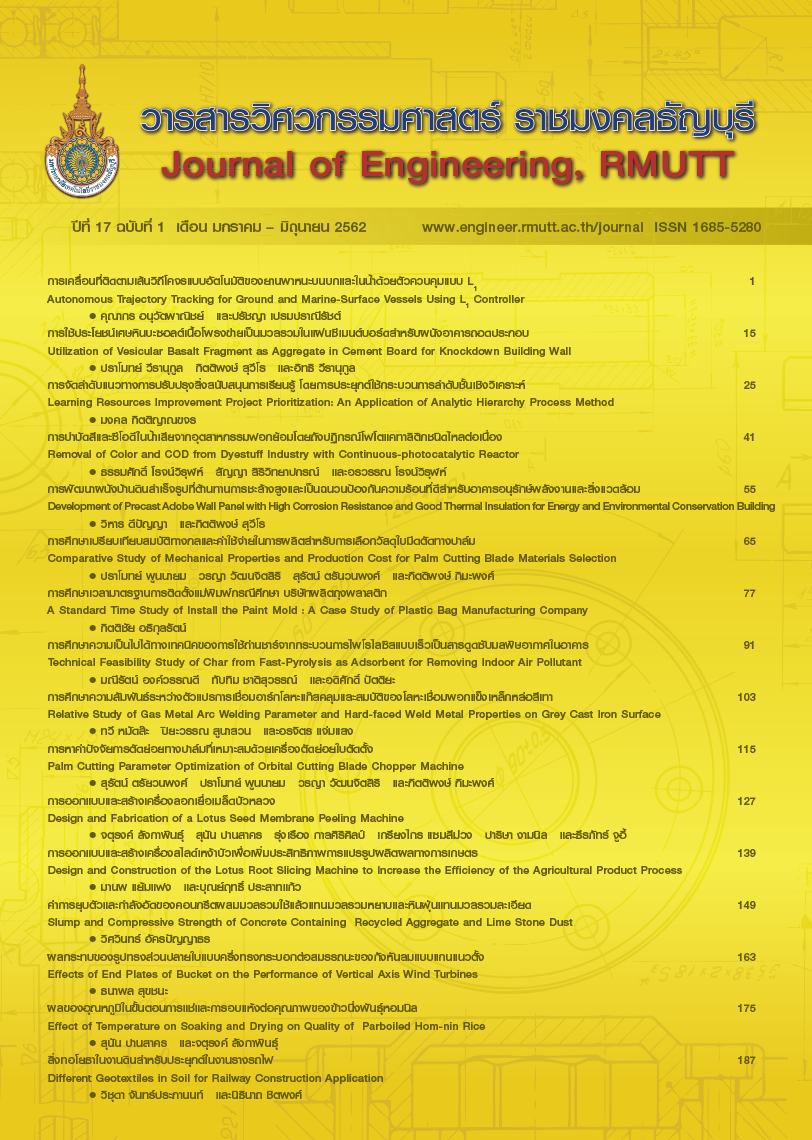สิ่งทอโยธาในงานดินสำหรับประยุกต์ในงานรางรถไฟ
##plugins.themes.bootstrap3.article.main##
摘要
การศึกษานี้มีจุดประสงค์เพื่อศึกษาการนำวัสดุทางสิ่งทอไปใช้ในงานดินสำหรับนำไปประยุกต์ใช้ในระบบขนส่งทางรางรถไฟ ผ้าไม่ทอสามตัวอย่างเตรียมด้วยเครื่องสางใยและกระบวนการยึดติดทางกลด้วยเครื่องปักเข็ม ซึ่งมีน้ำหนักประมาณ 200 – 600 กรัมต่อตารางเมตร และมีความหนาประมาณ 2 – 7 มิลลิเมตร ผ้าไม่ทอที่มีน้ำหนักมากที่สุด คือ 609.8 กรัมต่อตารางเมตร และมีความหนามากที่สุด คือ 6.76 มิลลิเมตร มีค่าการทนต่อแรงดึงและแรงดันทะลุสูง แต่มีสมบัติการซึมผ่านของอากาศและน้ำต่ำ เมื่อนำผ้าไม่ทอทั้งสามตัวอย่างและผลิตภัณฑ์สิ่งทอโยธาไปทำการทดสอบในงานดินด้วยการทดสอบ ซี บี อาร์ พบว่า การวางวัสดุสิ่งทอเหล่านี้ในระหว่างชั้นดิน ทำให้การต้านแรงกดอัดของดินมีค่าต่ำลง อย่างไรก็ตาม พบว่า ค่า ซี บี อาร์ ของชั้นดินที่มีการวางตัวอย่างผ้าไม่ทอที่มีน้ำหนักมากที่สุดมีค่าสูงกว่าค่า ซี บี อาร์ ของชั้นดินที่มีการวางตัวอย่างผลิตภัณฑ์สิ่งทอโยธาประมาณ 87 เปอร์เซ็นต์ นั่นคือ ชั้นดินที่มีตัวอย่างผ้าไม่ทอที่มีน้ำหนักมากสุดจากงานวิจัยนี้ สามารถทนแรงกดอัดได้มากกว่าชั้นดินที่มีผลิตภัณฑ์สิ่งทอโยธาที่ใช้งานจริง
##plugins.themes.bootstrap3.article.details##
The manuscript, information, content, picture and so forth which were published on Frontiers in engineering innovation research has been a copyright of this journal only. There is not allow anyone or any organize to duplicate all content or some document for unethical publication.
参考
Hemmachandra K. Technical Textiles. Bangkok: Offset Creations Co.,Ltd. 2006. (in Thai)
Koerner RM. Designing with geosynthetics Vol. 1. 6th ed. Kentucky: Xlibris Corporation. 2014.
Koerner RM. Chapter 11 geotextile used in separation. In: Koerner RM, editor. Geotextile from Design to Applications. Cambridge: Woodhead Publishing. 2016. p. 241–256.
Christopher BR. Chapter 14 geotextiles used in reinforcing paved and unpaved roads and railroads. In: Koerner RM, editor. Geotextile from Design to Applications. Cambridge: Woodhead Publishing. 2016. p. 305–335.
Rail Design Support Manual. cited 2016 October 21. Available from www.geofabrics.com
Ashpiz ES, Diederich R, Koslowski C. The use of spunbonded geotextile in railway track renewal St.Petersburg-Moscow. Proceeding of 7th International Conference on Geosynthetics, Nice, France, 2002. p. 1173-1176.
TenCate Polyfelt® in Dutch Rail Renovation. cited 2016 January 5. Available from www.tencate.com/txtures/winter-2011/TenCate-Polyfelt-in-Dutch-rail-renovation.aspx
Polyfelt® TS – Separation & Filtration Nonwovens. cited 2016 January 5. Available from https://www.buildsite.
com/pdf/tcmirafi/TenCate-Polyfelt-TS-Product-Data-1540984.pdf
Adam C, Apraku E, Opuku-Boahen R. Effect of triaxial geogrid reinforcement on CBR strength of natural gravel soil for road pavements. Journal of Civil Engineering Research. 2015;5(1): 45-51.
Çinçik E, ,Koç E. An analysis on air permeability of polyester/viscose blended needle-punched nonwovens. Text. Res. J. 2011;82(5): 430-442.
Kumar PS, Rajkumar R. Effect of geotextile on CBR strength of unpaved road with soft subgrade. Electronic Journal of Geotechnical Engineering. 2012;17: 1355-1363.
Kumar PS, Devi SP. Effect of needle punched nonwoven coir and jute geotextile on CBR strength of soft subgrade. ARPN Journal of Engineering and Applied Sciences. 2011;6(11): 114-116.
Naeini SA, Mirzakhanlari M. The effect of geotextile grading on the bearing ratio of granular soils. Electronic Journal of Geotechnical Engineering. 2008;13: 1-10.

